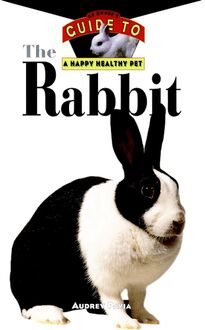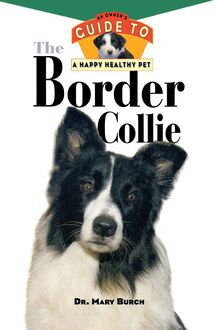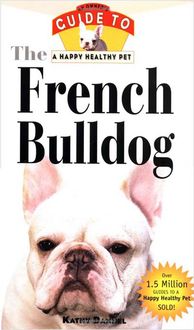-
 Univers
Univers
-
 Ebooks
Ebooks
-
 Livres audio
Livres audio
-
 Presse
Presse
-
 Podcasts
Podcasts
-
 BD
BD
-
 Documents
Documents
-
- Cours
- Révisions
- Ressources pédagogiques
- Sciences de l’éducation
- Manuels scolaires
- Langues
- Travaux de classe
- Annales de BEP
- Etudes supérieures
- Maternelle et primaire
- Fiches de lecture
- Orientation scolaire
- Méthodologie
- Corrigés de devoir
- Annales d’examens et concours
- Annales du bac
- Annales du brevet
- Rapports de stage
La lecture à portée de main
Vous pourrez modifier la taille du texte de cet ouvrage
Découvre YouScribe en t'inscrivant gratuitement
Je m'inscrisDécouvre YouScribe en t'inscrivant gratuitement
Je m'inscrisEn savoir plus
Vous pourrez modifier la taille du texte de cet ouvrage
En savoir plus

Description
* Expert authors, plus renowned guest contributors on specialized topics
* Full-color photos throughout
* Basic information on the breed, species, or topic
* Complete coverage of care, health, grooming, training, and more
* Tips and techniques to make life with a pet more rewarding
PART ONE: Welcome to the World of the Shetland Sheepdog.
1. What Is a Shetland Sheepdog?
2. The Shetland Sheepdog's Ancestry.
3. The World According to the Shetland Sheepdog.
PART TWO: Living with a Shetland Sheepdog.
4. Bringing Your Shetland Sheepdog Home.
5. Feeding Your Shetland Sheepdog.
6. Grooming Your Shetland Sheepdog.
7. Keeping Your Shetland Sheepdog Healthy.
PART THREE: Enjoying Your Dog.
8. Basic Training (lan Dunbar, Ph.D., MRCVS).
9. Getting Active with Your Dog (Bardi McLennan).
10. Your Dog and Your Family (Bardi McLennan).
11. Your Dog and Your Community (Bardi McLennan).
PART FOUR: Beyond the Basics.
12. Recommended Reading.
13. Resources.
Sujets
Informations
| Publié par | Turner Publishing Company |
| Date de parution | 05 mai 2008 |
| Nombre de lectures | 1 |
| EAN13 | 9780470366851 |
| Langue | English |
Informations légales : prix de location à la page 0,0900€. Cette information est donnée uniquement à titre indicatif conformément à la législation en vigueur.
Extrait
Copyright 1995 by Wiley Publishing, Inc., New York, NY
Howell Book House
Published by Wiley Publishing, Inc., New York, NY
All rights reserved. No part of this book may be reproduced or transmitted in any form or by any means, electronic or mechanical, including photocopying, recording, or by an information storage and retrieval system, without permission in writing from the Publisher.
No part of this publication may be reproduced, stored in a retrieval system or transmitted in any form or by any means, electronic, mechanical, photocopying, recording, scanning or otherwise, except as permitted under Sections 107 or 108 of the 1976 United States Copyright Act, without either the prior written permission of the Publisher, or authorization through payment of the appropriate per-copy fee to the Copyright Clearance Center, 222 Rosewood Drive, Danvers, MA 01923, (978) 750-8400, fax (978) 750-4744. Requests to the Publisher for permission should be addressed to the Legal Department, Wiley Publishing, Inc., 10475 Crosspoint Blvd., Indianapolis, IN 46256, (317) 572-3447, fax (317) 572-4447, E-Mail: permcoordinator@wiley.com.
Trademarks: Wiley, the Wiley Publishing logo and Howell Book House are trademarks or registered trademarks of Wiley Publishing, Inc., in the United States and other countries, and may not be used without written permission. All other trademarks are the property of their respective owners. Wiley Publishing, Inc., is not associated with any product or vendor mentioned in this book. Limit of Liability/Disclaimer of Warranty: While the publisher and author have used their best efforts in preparing this book, they make no representations or warranties with respect to the accuracy or completeness of the contents of this book and specifically disclaim any implied warranties of merchantability or fitness for a particular purpose. No warranty may be created or extended by sales representatives or written sales materials. The advice and strategies contained herein may not be suitable for your situation. You should consult with a professional where appropriate. Neither the publisher nor author shall be liable for any loss of profit or any other commercial damages, including but not limited to special, incidental, consequential, or other damages.
For general information on our other products and services, please contact our Customer Care Department within the U.S. at 800-762-2974, outside the U.S. at 317-572-3993 or fax 317-572-4002. Wiley also publishes its books in a variety of electronic formats. Some content that appears in print may not be available in electronic books.
Library of Congress Cataloging-in-Publication data
Merrithew, Cathy.
The Shetland Sheepdog: an owner s guide to happy, healthy pet
p.cm.
Includes bibliographical references
ISBN 0-87605-385-1 1. Shetland Sheepdog. I. Title.
SF429.S62M47 1995
636.7 37-dc20 95-24703
CIP
Manufactured in the United States of America
10 9 8 7
Series Director: Dominique De Vito
Series Assistant Director: Felice Primeau
Book Design: Michele Laseau
Cover Design: Iris Jeromnimon
Illustration: Jeff Yesh
Photography:
Cver photos: puppy, Cathy Merrithew; adult Judith Strom
Courtesy of the American Kennel Club: 17, 18, 21
Joan Balzarini: 96
Mary Bloom: 34-35, 45, 96, 136, 145
Paulette Braun/Pets by Paulette: 5, 7, 16, 65, 74, 96
Buckinghamhill American Cocker Spaniels: 148
Sian Cox: 134
Dr. Ian Dunbar: 98, 101, 103, 111, 116-117, 122, 123, 127
Dan Lyons: 96
Cathy Merrithew: 47, 129
Liz Palika: 133
Janice Raines: 132
Susan Rezy: 96-97
Judith Strom: 2-3, 8, 9, 11, 13, 20, 22, 23, 24, 25, 27, 28, 29, 31, 36, 39, 41, 42, 43, 48, 52, 55, 56, 57, 59, 61, 63, 69, 83, 96, 107, 110, 128, 130, 135, 137, 139, 140, 144, 149, 150 Kerrin Winter/Dale Churchill: 80
Production Team: Troy Barnes, John Carroll, Jama Carter, Kathleen Caulfield, Trudy Coler, Vic Peterson, Terry Sheehan, Marvin Van Tiem, Amy DeAngelis and Kathy Iwasaki
Contents
part one
Welcome to the World of the Shetland Sheepdog
1 What Is a Shetland Sheepdog?
2 The Shetland Sheepdog s Ancestry
3 The World According to the Shetland Sheepdog
part two
Living with a Shetland Sheepdog
4 Bringing Your Shetland Sheepdog Home
5 Feeding Your Shetland Sheepdog
6 Grooming Your Shetland Sheepdog
7 Keeping Your Shetland Sheepdog Healthy
part three
Enjoying Your Dog
8 Basic Training
by Ian Dunbar, Ph.D., MRCVS
9 Getting Active with Your Dog
by Bardi McLennan
10 Your Dog and Your Family
by Bardi McLennan
11 Your Dog and Your Community
by Bardi McLennan
part four
Beyond the Basics
12 Recommended Reading
13 Resources
chapter 1
What is a Shetland Sheepdog?
Picture this: Out for a walk, you spot a gorgeous, smallish, robust dog, running, leaping and barking, tail wagging. Playing with the neighborhood children, his tongue hanging out, it s obvious they have been at it quite some time. As you approach, he stops playing, fixes his eyes on you and watches. Nonchalantly circling his flock, he makes sure you are not going to be a threat to him or his charges. As you draw nearer, you start to admire the dog. He is extremely attractive and it is obvious he has a job to do. As you go past, and glance back over your shoulder, you see that play has resumed, and you go on but never forget that little dog.
You have just met your first Sheltie.
General Appearance
The Shetland Sheepdog truly is a breed of great beauty, intelligence and alertness. Many people refer to them as miniature Collies, and while that may have been true in the early days of the breed, it is not true now. Shetland Sheepdogs are bred true-devoid of any crosses to the Collie or other breeds-and have been for many generations. They are a very manageable, portable size, which suits many families who want a pet they can take anywhere while not taking up too much room. To gain a more complete understanding of the Shetland Sheepdog, we look to the American standard, which describes the Sheltie as a small, alert, roughcoated, longhaired dog. The general look of the Sheltie should be of a dog that is balanced, slightly longer in body than height, with a proud stance, head held high, not cringing or flattening along the ground. In the following discussion, the sections in italics are taken directly from the American Kennel Club standard; the rest is commentary.
WHAT IS A BREED STANDARD?
A breed standard-a detailed description of an individual breed-is meant to portray the ideal specimen of that breed. This includes ideal structure, temperament, gait, type-all aspects of the dog. Because the standard describes an ideal specimen, it isn t based on any particular dog. It is a concept against which judges compare actual dogs and breeders strive to produce dogs. At a dog show, the dog that wins is the one that comes closest, in the judge s opinion, to the standard for its breed. Breed standards are written by the breed parent clubs, the national organizations formed to oversee the well-being of the breed. They are voted on and approved by the members of the parent clubs.
S IZE
Described as a small breed, the dog should stand between 13 and 16 inches at the shoulder. Note: Height is determined by a line perpendicular to the ground from the top of the shoulder blades. Disqualification - Heights below or above the desired range are to be disqualified from the show ring.
To properly measure your dog, place it on a hard, level surface. Part and move the hair away from the highest point of the shoulder blades. Make sure the front legs are straight, with the head in its normal position. Place a ruler or other straight object on the top part of the shoulder blades, making sure it is across, level, and mark the height on a yardstick held next to the front legs. Historically, a Sheltie over sixteen inches was too big and expensive for the founders of the breed to keep and maintain, and a tiny Sheltie was not able to withstand the rigors of working sheep all day over the rough, uneven terrain. Breeders also questioned whether a tiny herder could properly defend himself or his flock.
The Sheltie has no problem navigating rough terrain.
Over the years, dogs in the thirteen-to-sixteen-inch height range have best been able to withstand working the countryside. Although dogs under or over the size limit are disqualified from competing toward a championship title, they do not make lesser companions. They may not pass the inspection of a judge, but they will excel as active family pets. Shelties are also high scorers in the obedience ring.
C OAT
The correct coat should be double, the outer coat consisting of long, straight, harsh hair; the undercoat short, furry, and so dense as to give the entire coat its stand off quality. The hair on the face, tips of ears and feet should be smooth. Mane and frill should be abundant, and particularly impressive in males. The forelegs well feathered, the hind legs less so, but smooth below the hock joint. Hair on tail profuse.
Without the important outercoat, the coat would become like a sponge, soaking up rain and moisture and preventing the dog from working all day in damp conditions. A full, thick neck ruff is very important because it protects the dog from attackers. Faults are listed as: Coat short or flat, in whole or in part; wavy, curly, soft or silky. Lack of undercoat. Smooth coated specimens.
Color: Color is immaterial from a working standpoint, because a good herding dog can be any color. It is said that sheep better distinguish the dog if it is not all white, since that is the sheep s own color. But how can a dog herding all day in bad weather stay its own color anyway? Allowable colors for the show ring are: sable, which ranges from golden to red to deep mahogany with an overlay of black; tricolor, which should be an intense black with tan and white markings; blue merle, which is a basic background color of silvery blue with black merled
-
 Univers
Univers
-
 Ebooks
Ebooks
-
 Livres audio
Livres audio
-
 Presse
Presse
-
 Podcasts
Podcasts
-
 BD
BD
-
 Documents
Documents
-
Jeunesse
-
Littérature
-
Ressources professionnelles
-
Santé et bien-être
-
Savoirs
-
Education
-
Loisirs et hobbies
-
Art, musique et cinéma
-
Actualité et débat de société
-
Jeunesse
-
Littérature
-
Ressources professionnelles
-
Santé et bien-être
-
Savoirs
-
Education
-
Loisirs et hobbies
-
Art, musique et cinéma
-
Actualité et débat de société
-
Actualités
-
Lifestyle
-
Presse jeunesse
-
Presse professionnelle
-
Pratique
-
Presse sportive
-
Presse internationale
-
Culture & Médias
-
Action et Aventures
-
Science-fiction et Fantasy
-
Société
-
Jeunesse
-
Littérature
-
Ressources professionnelles
-
Santé et bien-être
-
Savoirs
-
Education
-
Loisirs et hobbies
-
Art, musique et cinéma
-
Actualité et débat de société
- Cours
- Révisions
- Ressources pédagogiques
- Sciences de l’éducation
- Manuels scolaires
- Langues
- Travaux de classe
- Annales de BEP
- Etudes supérieures
- Maternelle et primaire
- Fiches de lecture
- Orientation scolaire
- Méthodologie
- Corrigés de devoir
- Annales d’examens et concours
- Annales du bac
- Annales du brevet
- Rapports de stage




















